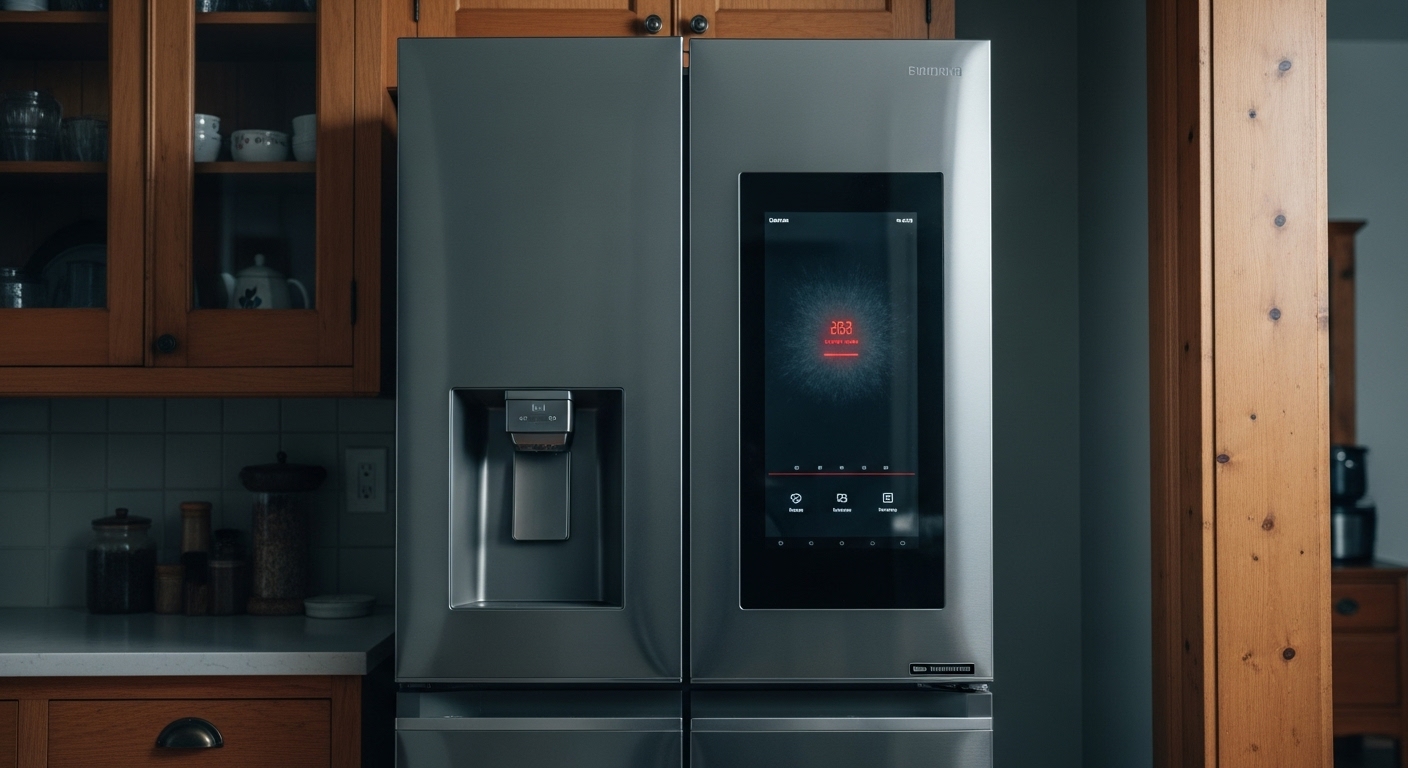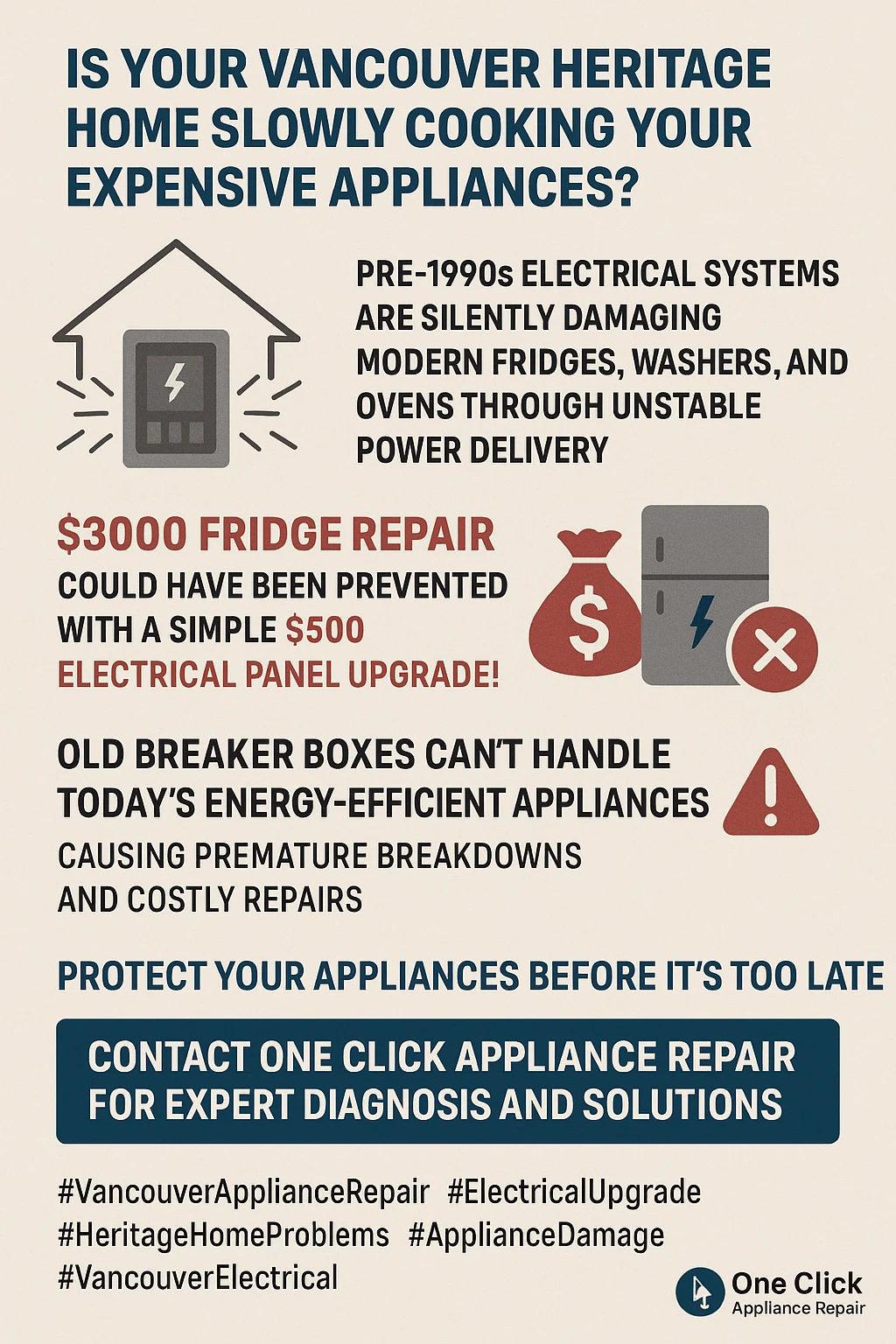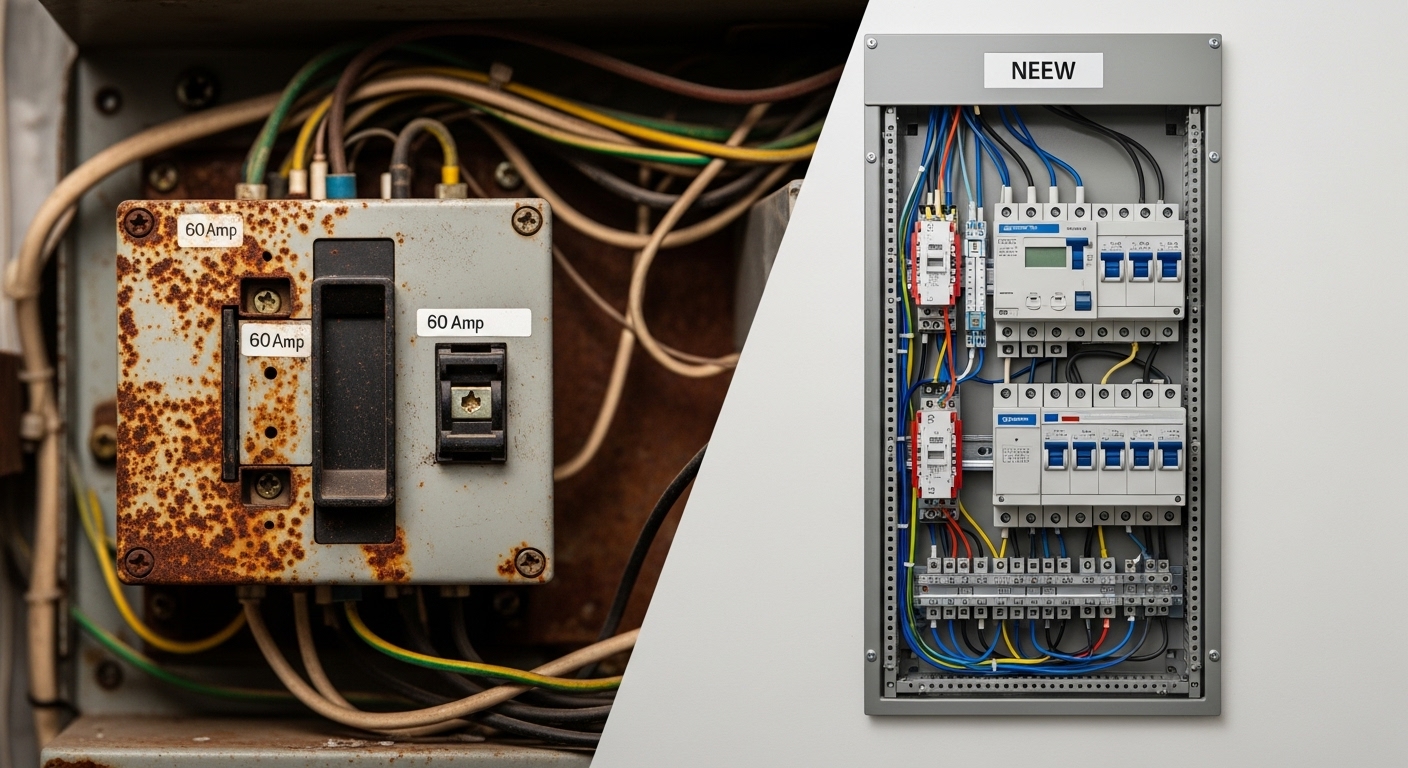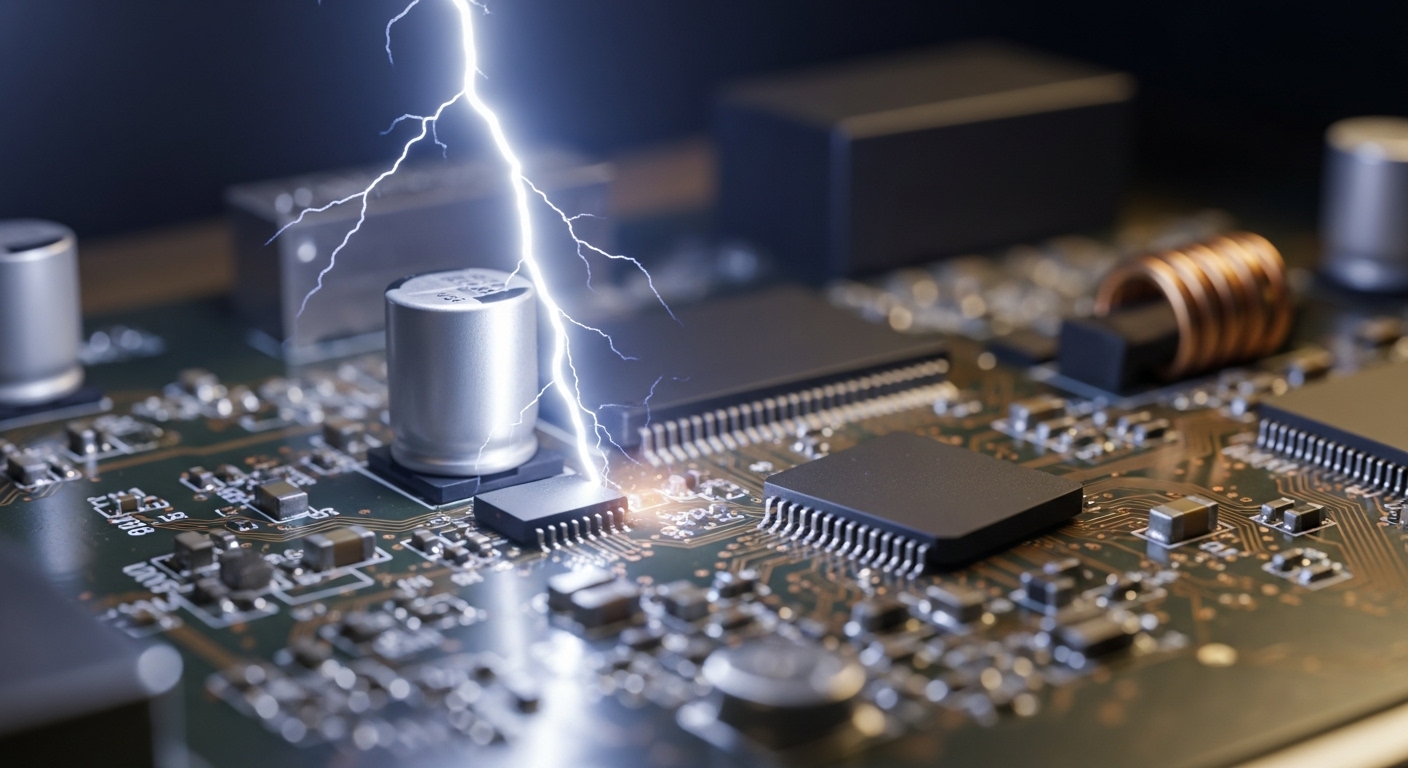Worried about your expensive smart appliances getting slowly fried by Vancouver’s aging electrical systems? You’re absolutely right to be concerned – thousands of Vancouver homeowners are discovering that their heritage home’s charming character comes with a hidden electrical crisis that’s systematically destroying modern appliances worth tens of thousands of dollars.
Picture this: you’ve just invested $5,000 in a gorgeous smart refrigerator, high-efficiency dishwasher, and connected washing machine for your beautiful Kitsilano heritage home. Everything looks perfect until your fridge starts displaying random error codes, your dishwasher trips the circuit breaker every third cycle, and your washing machine’s digital display flickers ominously during the spin cycle. This isn’t just bad luck or faulty appliances – it’s the unfortunate reality of trying to run 21st-century technology on electrical systems that were designed when most homes had maybe three outlets total.

What makes this situation particularly devastating for Vancouver homeowners is that the damage often goes unnoticed until it’s too late to prevent major appliance failures. Your home’s aging electrical system isn’t just an inconvenience – it’s actively working against your modern appliances every single day through power surges, voltage fluctuations, and electrical instabilities that slowly degrade sensitive electronic components. While you’re going about your daily routine, your electrical system is experiencing approximately 20 power surges daily, with each small voltage spike chipping away at your appliances’ internal circuits like invisible electrical termites.
The financial stakes couldn’t be higher when you consider that the average Vancouver home now contains approximately $15,000 worth of surge-sensitive electronics and appliances. From smart TVs and gaming systems to high-tech kitchen appliances and connected home devices, these modern marvels contain sophisticated electronic components that are exponentially more vulnerable to electrical problems than the simple motors and heating elements of older appliances. One major electrical event can instantly transform thousands of dollars worth of perfectly functioning appliances into expensive paperweights, and most homeowners don’t realize the cumulative damage is happening until warranties have expired.
Key Takeaways
- Vancouver homes experience approximately 20 daily power surges that slowly degrade modern appliance electronics, with 60-80% originating from internal sources that pre-1990s electrical systems cannot properly manage
- The average Vancouver home contains $15,000 worth of surge-sensitive electronics and appliances that are exponentially more vulnerable to electrical fluctuations than traditional mechanical appliances
- Pre-1990s Vancouver homes typically operate on 60-100 amp electrical service while modern households require 200-amp service, creating chronic overloading conditions that damage appliances daily
- Vancouver’s coastal climate accelerates electrical component corrosion by up to 40% compared to drier regions, compounding appliance vulnerability to power fluctuations
- The CleanBC Better Homes program offers a $500 rebate for electrical service upgrades when converting from fossil fuel heating, making comprehensive electrical protection more affordable for Vancouver homeowners

The Hidden Electrical Crisis in Vancouver’s Pre-1990s Homes
Walking through Vancouver’s charming neighborhoods like Kitsilano, Mount Pleasant, and Commercial Drive, you’ll see beautiful heritage homes that represent decades of architectural history. However, behind those character-filled facades lies a brewing electrical crisis that’s putting modern appliances at serious risk. Many Vancouver homes built before the 1950s still contain knob-and-tube wiring systems, which were innovative for their time but are now considered electrical antiquities. These systems consist of copper conductors running through walls and ceilings, supported by porcelain knobs and passing through ceramic tubes in drilled holes.
The critical flaw in knob-and-tube systems is their lack of ground wires, making them fundamentally incompatible with modern three-pronged appliances that rely on proper grounding for both safety and optimal performance. When you plug a sophisticated smart appliance into an ungrounded electrical system, you’re essentially asking a computer to operate without proper electrical protection. The electrical panel situation in older Vancouver homes presents another layer of complexity that directly threatens modern appliances.
Most heritage homes were originally equipped with 60-amp or 100-amp electrical service, which was perfectly adequate when the most power-hungry device in the house might have been a hair dryer. Today’s smart homes typically require 200-amp service to safely handle the simultaneous operation of multiple high-power appliances, electric vehicle chargers, HVAC systems, and the dozens of electronic devices that define modern living. When you force modern electrical demands through an undersized electrical service, the result is chronic overloading that creates perfect conditions for appliance damage.

Vancouver’s coastal climate creates some unique challenges that inland cities don’t face. The salt air from our proximity to the Pacific Ocean gradually corrodes electrical connections throughout your home’s wiring system. This corrosion makes your appliances even more vulnerable to voltage spikes because compromised connections can’t handle electrical stress as effectively. Vancouver’s coastal climate accelerates electrical component corrosion by up to 40% compared to drier regions, making appliances more vulnerable to power fluctuations over time. It’s like having a weakened immune system for your electrical system – when surges hit, the damage can be more severe than in drier, inland locations.
The absence of modern safety features like GFCI and AFCI protection in older homes creates additional vulnerability for expensive appliances. GFCI outlets are essential in areas with water exposure, such as kitchens and laundry rooms, while AFCI protection guards against arc faults that can occur in aging wiring. Without these protections, appliances face increased risk of damage from electrical faults, and homeowners lack the early warning systems that could prevent catastrophic appliance failures.
How Old Electrical Systems Actually Kill Your Appliances
Now that we’ve established the scope of Vancouver’s electrical infrastructure problem, let’s examine exactly how these aging systems systematically destroy your valuable appliances. The most insidious aspect isn’t the dramatic failures that make headlines – it’s the constant, invisible electrical stress that slowly degrades your appliances every single day. Your home’s electrical system is experiencing approximately 20 power surges daily, with each voltage spike gradually weakening the delicate electronic components inside your valuable appliances.

What makes this situation particularly challenging is that 60-80% of these damaging surges are generated internally when your own appliances cycle on and off throughout the day. The National Electrical Manufacturers Association has found that somewhere between 60% to 80% of surges are actually created inside your own home when large appliances cycle on and off. Every time your air conditioner kicks in, your electric dryer starts a new cycle, or your refrigerator’s compressor fires up, it creates electrical ripples throughout your home’s wiring system.
Smart appliances represent a particular vulnerability in this electrical environment because they’re essentially sophisticated computers disguised as household equipment. Smart appliances contain sophisticated electronic components that are exponentially more sensitive to electrical fluctuations than traditional appliances with simple mechanical systems. Your Wi-Fi enabled refrigerator, connected washing machine, and smart thermostat all contain microprocessors, circuit boards, and sensitive electronic components that require clean, stable power to function properly. Unlike traditional appliances that could tolerate significant electrical fluctuations through simple mechanical systems, smart appliances can suffer permanent damage from voltage spikes that older appliances would simply shrug off.
The cumulative nature of surge damage makes this problem particularly insidious because appliances rarely fail immediately after a single electrical event. Instead, each voltage spike gradually degrades capacitors, weakens solder joints, and stresses protective circuits inside your appliances. Each little voltage spike stresses the capacitors, circuit boards, and control systems inside your appliances. Minor power surges affect appliances, and damage often accumulates, leading to higher power draw and heftier electricity bills even before the appliance completely fails.
When voltage drops occur – which often happen right before or after a surge – your appliances’ motors are forced to draw more current to compensate for the reduced power supply. This extra current draw causes overheating and puts enormous stress on electrical components that weren’t designed to handle the additional load. This is particularly problematic for refrigerator compressors, washing machine motors, and HVAC systems, which can burn out prematurely when repeatedly subjected to voltage fluctuations in homes with undersized electrical service. Once surge-damaged appliances have compromised internal protection circuits, they become progressively more vulnerable to future electrical events, creating a vicious cycle where damaged appliances become sitting ducks for the next electrical event that comes along.
The Real Financial Impact Beyond the Sticker Price
The true cost of aging electrical systems extends far beyond simple appliance replacement expenses, creating a complex web of financial consequences that most Vancouver homeowners don’t fully understand until they’re facing thousands in unexpected bills.



